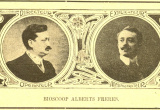Cinéma parlant
On 11 November 1911, the Mullens brothers (Alberts Frères) started up a series of ‘cinéma parlant’ (‘talking film’) shows in the Paleis voor Volksvlijt (‘Palace of Industry’) in Amsterdam. There were some logistical problems in the beginning: after the opening night, the fire brigade threatened to shut down the shows due to fire hazards they found. Ultimately all the safety requirements were met and, after an interruption of nearly three weeks, the shows were finally allowed to go on.
Crowing roosters
The programme started off with an introduction by one of the brothers. After that, the other brother appeared on the screen and spoke clearly to the audience. This was followed by the screening of a number of ‘talking films’: a crowing rooster, a banjo player, a drunken Parisian, and so on. Generally speaking, the sound quality was good; it was only the spoken parts that were occasionally problematic.
Gaumont’s new technique
For the reproduction of image and sound, Alberts Frères used a system developed by the French company Gaumont whereby a film was played synchronously with accompanying sound from a gramophone record. This technique was not new, and was used in a number of shows during the previous decades. The Mullens brothers had already used it in 1904 and 1908 in their shows – advertising it as the ‘Phono-Bio’, and Alex Benner used a similar technique for his Benner’s Sprekende Bioscope.
In 1904 they used a combination of film and gramophone developed by the Lumière brothers. On this occasion, they also shot a few of their own films with synchronised soundtracks that included well-known operetta melodies and folksy popular songs such as Drinken we nog een dropske and Bertha van de schiettent. The live music during their shows was provided by then-famous comedian and couplet singer Maurice Dumas.
A review of the performance in the Paleis voor Volksvlijt wrote that the sound quality during these earlier shows was less than optimal; in any case, it wasn’t as good as the new technique developed by Gaumont, which substantially improved the synchronisation and the volume.
Sound and music
The accompaniment of motion pictures with sound and music had been around since the early years of film: often a pianist or an orchestra played along with the images. Some musicians, such as Boris Lensky and Max Tak, achieved national acclaim through their work. From the very beginning, however, there were also experiments in synchronising sound with moving images. The combination of film and gramophone sound is the most well-known form of this, despite the fact that the system had a number of flaws.
In 1904, French film pioneer and inventor Eugene Augustin Lauste (father of the Mutoscope cameraman Emile Lauste) developed a system that included a soundtrack on the film itself. In 1906 he patented another invention that allowed the soundtrack to be played via a light sensor. It would take years, however, before films with synchronised soundtracks outgrew their experimental phase and sound film made its debut in regular cinemas.
more information
If you are looking for more material from our collection, please contact Film Sales:
sales@eyefilm.nl
phone +31 (0)20 5891 426


